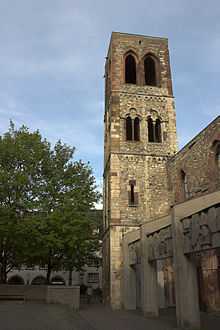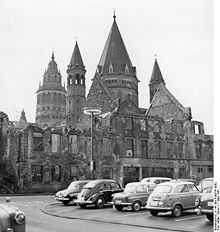Bombing of Mainz in World War II

The German city of Mainz was bombed in multiple air raids by the Allies during World War II by the Royal Air Force (RAF), as well as the United States Army Air Forces. These led to numerous victims and heavy damages throughout the city scape.
Overview of major air raids
- Altstadt, Mombach (11/12 and 12/13 August 1942)
- Bischofsheim (9 September 1942, autumn 1944, 13 und 27 January 1945, 27. February 1945)
- Ginsheim (23/24 April 1944)
- Gonsenheim (Kathen-Kaserne: 19 Oktober 1944)
- Gustavsburg (particularly 9, 15 September 1944 and 27 Februar 1945)
- Mainz-Kastel (particularly 8 September 1944)
- Mainz-Kostheim (autumn 1944)
- Mainz-Neustadt (11/12 und 12/13 August 1942, 20 December 1943, autumn 1944, 1 February and 27 February 1945)
- Mainz-Weisenau (particularly 19 Oktober 1944, 1 February and 27 Februar 1945)
1939 to 1941
After the beginning of World War II only minor unguided aerial bombs, were delivered by the Royal Air Force during the first two years of the war. The first major British air raid took place on 13 September 1941 targeting Mainz Hauptbahnhof (Mainz main station). 22 people died during this attack, originally scheduled for Frankfurt am Main.
1942 to 1943

Until August 1942 only small air raids took place. On 11 August 1942 the RAF Bomber Command launched 158 British bombers for performing an operation targeting at Mainz in the framework of the Area Bombing Directive amended to the General Directive No.4, issued by the British Air Ministry on 5 February 1942. This directive determined the “European Theater of Operations” for the rest of the war. During the following night 200 tons of bombs were dropped, comprising the dangerous white phosphorus bombs. During the next night 133 aircraft attacked the city. Again approximately 180 tons of bombs were dropped. These bombs hit to a great extend the old city center and the Cathedral, but also parts of the town extension of the 1870s, the Neustadt, and Mombach.[1] St. Nikolaus church in Mombach, finalized with its bell tower in 1703, was destroyed by incendiary bombs. St. Stephen's Church was heavily damaged, St. Johannis burnt out completely, the Invalidenhaus for the disabeled was ruined. Hundreds of people died in the flames. Nonetheless some quarters in the core city remained inhabitable. On 9 September 1942 allied bombers bombed Bischofsheim. The air defences of Mainz were aided by an anti-aircraft battery set up on the premises of today's University of Mainz.
1944
In the course of the year 1944 the intensity of the aerial warfare increased. A British emergency drop during the night of 23 to 24 April led to multiple fire in parts of Ginsheim. Through this the evangelic church was destroyed. In the autumn targeted attacks on the city accumulated. On 8 September Kastel was hit hard and again Gustavsburg on the 8th and 15 September. Parts of Kostheim were bombed on 8 September and Mainz-Weisenau on 19 Oktober. On the same day the Kathen barracks in Gonsenheim were destroyed by bombing and fire. Throughout the autumn, there were perpetual alerts for over-flying bombers.
On 18 December 1944 the railway infrastructure around Mainz became targeted. According to released operation reports of the US Army Air Force 157 four-engine heavy bombers Boeing B-17 Flying Fortress of the Eighth Air Force dropped 430,7 metric tons of explosive bombs from 27000 ft height in several waves during 01:45 to 01:59 pm. 89 people died.
1945
January 1945
On 13 and 27 January the Eighth Air Force bombed railway facilities in Bischofsheim and Gustavsburg. A large-scale attack on Mainz was planned by RAF for 1 February, but the bombs missed their target and landed in the majority on the ‘Großberg’ in Weisenau. The Christuskirche was destroyed that day by incendiary bombs and a subsequent fire to the outer walls and the steel skeleton of its dome.
Air raid on 27 February 1945
On 27 February 1945 the RAF flew 435 bombers to attack the city. Between 16:29 and 16:45 hours 1,500 tons of bombs were dropped, hit large parts of the Neustadt. St. Joseph and St. Boniface were destroyed. The old city centre, bombed in 1942 was not affected. A strong firestorm spread over a large area. Also Weisenau, Gustavsburg and Bischofsheim were hit hard. Burnt material had flown according to eyewitness reports as far as Gonsenheim. The number of dead was with 1209 low in comparison to other cities. Some of them were buried in the Waldfriedhof (forest cemetery) in Mombach. The real goal of the air raid, the railway premises, remained undamaged. Three days after the attack trains could drive again.
Disembarrassment by the Americans and French occupation
On 22 March 1945, the war ended for the city of Mainz, destroyed by 80 percent. Units of the Wehrmacht and Volkssturm withdrew across the Rhine from the city surrendered without a fight back or front to the Third US Army under General George S. Patton. Until July 1945 Mainz remained under American administration, after that Mainz was placed under French administration.
Further reading
- collection:Yad Vashem Photo Archive
- Spiegel-online photo gallery
- Margaret Bourke-White Mainz, Germany in: LIFE Photo Collection
- Margaret Bourke-White collection
- Bomb Damage In Mainz
- Jörg Friedrich: The Fire: The Bombing of Germany, 1940-1945 translated by: Allison Brown, illustrated, Columbia University Press, 2008, ISBN 9780231133814
Notes and references
| ||||||||||||||||||||||||||||||||||
| ||||||
| ||||||||||||||||||||||||||||||||||||||||||||||||||||||||||||||||||||||||||||||||